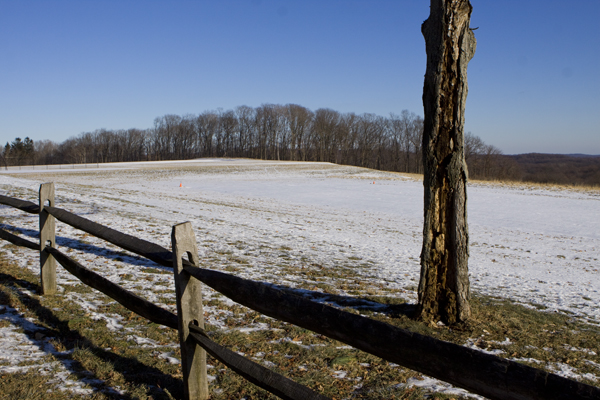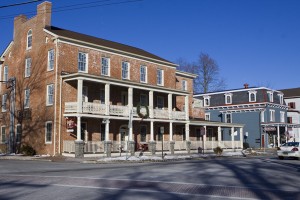
fields and forests of Chester, NJ
No man is an Island intire of it selfe; every man is a peece of the Continent, a part of the maine; …. any mans death diminishes me, because I am involved in Mankinde; And therefore never send to know for whom the bell tolls; It tolls for thee.
~~~~ John Donne (quoted in Hemingway)
Most people don’t associate historic upscale Chester, NJ – home of the Highlands Council – with toxic industrial chemical air pollution.
Neither do I or DEP scientists.

historic downtown Chester, NJ
So, when DEP designed an urban air toxics & environmental justice study for Paterson, they selected suburban Chester as a “clean air” site to monitor background levels for comparison to what they found in urban Paterson (we will write about the larger and far more significant Paterson study shortly).
But, as I found during the course of reviewing DEP files, something odd happened when the monitoring results came back.
DEP scientists found unexpected results – levels of the toxic chemical carbon disulfide – a volatile chemical used in manufacturing and processing activities. According to the federal Agency for Toxic Substances and Disease Registry (ATSDR), the leading experts:
Studies in animals indicate that carbon disulfide can affect the normal functions of the brain, liver, and heart. After pregnant rats breathed carbon disulfide in the air, some of the newborn rats died or had birth defects (see this ATSDR profile for complete health and environmental effects).
Science is all about hypothesis testing – comparison of the expected value with the data for the observed values. So, because of the research study’s implicit “clean air” hypothesis, DEP now had a real scientific unknown on their hands.
So, what did they do with this mysterious data? Where is the Chester monitoring station? What were the levels detected? What are the sources of this pollution? What are the human exposure and health risks? What is DEP doing to reduce emissions of carbon disulfide? What does DEP do to notify and involve communities in relevant health risk information and risk reduction strategies?
The answers to these basic questions might surprise you – and they illustrate a series of significant systemic flaws in how DEP conducts science, regulates pollution, and works with communities and local officials.
Here’s what I was able to find. Unfortunately, because the EPA funded $700,000+ DEP study – completed over 2 years ago – still has not been published, formally publicly released, or posted on the DEP website, we don’t know answers to basic questions.
So, to answer these questions, I called and emailed the lead DEP scientist and DEP press office. Both arrogantly refuse to even provide the professional courtesy of a reply. I filed an OPRA public records requests over a month ago, yet still have not yet be given all documents by DEP. I asked the DEP environmental justice coordinator about the study and was told that the study was federally funded and that EPA would not allow DEP to release the research data (Note: I believe this is a lie]. I called the Chester Health Department and spoke with the contract Health Officer – both knew nothing about this DEP monitoring station or carbon disulfide levels in Chester. So DEP failed to disclose data to local officials, health professionals, and the public.
The Chester data prompted the study’s lead DEP scientists to ask DEP colleagues to track down and locate potential sources of the chemical – here’s the verbatim DEP email exchange:
Hi Brad,
Looks like all the high values are from Chester. Most of the hits actually. Could you look into EI [emissions inventory] around Chester to see if we have a potential source?
Thanx
Linda – as you’ll see from the spreadsheet there are only 3 potential sources of Carbon disulfide in Morris county, none of which are in Chester. …. The emissions are from the potential to emit section of the [air] permits. Carbon disulfide is not a required reported pollutant under the [air permit] emissions statements program so that is why I had to use the potential to emit information. EPA’s TRI (Toxic Release Inventory) has no emissions of carbon disulfide in Morris County. I also checked the RPPR and the results are the same.
John Jenks, Bureau Chief of DEP Technical Services then jumps in the email discussion to say:
This is why listing 200 or so compounds is not enough. The Air Toxics Initiative will fix that. CS2 (carbon disulfide) is bad stuff. Although it is not on the TRI maybe everybody realizes how bad it is and don’t use it anymore.
The next day, Brad follows up. Remarkably, despite the ATSDR profile (excerpted above) and the man made industrial emission sources he ignores in his own information (plus not properly citing his information source), Brad speculates that the mysterious source of this industrial chemical might be local wetlands! That’s right, in the heart of the chemical wasteland of NJ, blame it on nature! That way, DEP doesn’t have to do anything to regulate emissions:
Linda – here are some of the sources/uses of Carbon Disulfide. I read somewhere else …that carbon disulfide is given off by swamps/wetlands. Not sure if there are any right around the Chester monitor site but it could be a potential source and may solve the mystery of why the monitor is showing a pollutant that has no facilities around the monitor emitting it. Hope this helps.
Sources/Uses
Carbon disulfide is a natural product of anaerobic biodegradation. It is also synthesized via the catalyzed reaction between sulfur and methane at 600 degrees C [Note: I don’t think you’ll find those conditions in local wetlands!]. Carbon disulfide is used in the manufacture of viscose rayon, cellophane, carbon tetrachloride, dyes, and rubber. Some solvents, waxes, and cleaners contain carbon disulfude. It is also used as an insecticide.
Based only on the DEP file review, I can tell you that DEP scientists calculated a “combined cancer risk” of 318 for Chester. Although I do not know what a “combined cancer risk” means, it appears to reflect the cumulative cancer risks of multiple detected hazardous air pollutants.
Stay tuned for the far more significant results from Paterson.
Here are the 3 Morris County carbon disulfide emissions sources DEP identified:
River Park Business Center – Hanover Township
Specialty Melt Division – Florham Park Boro
Denville Technical PK Alliant TechSystems Inc. – Denville Township

Pingback: WolfeNotes.com » NJ DEP Submits Clean Air Act Ozone Plan To EPA For Review And Approval – Who Knew?